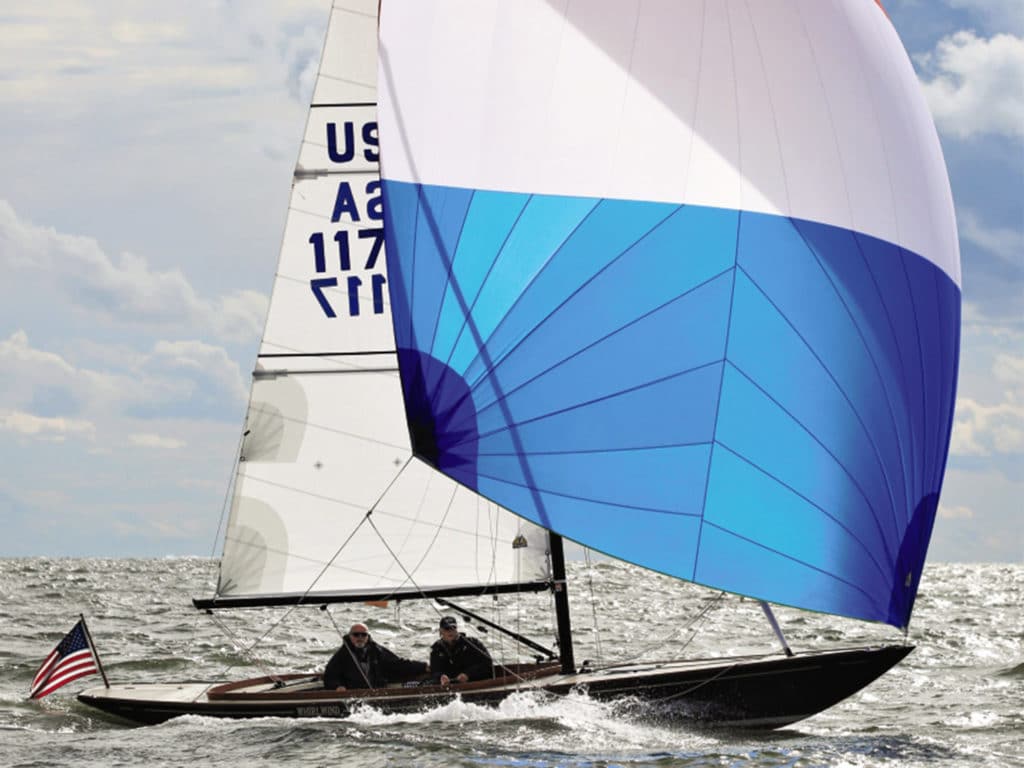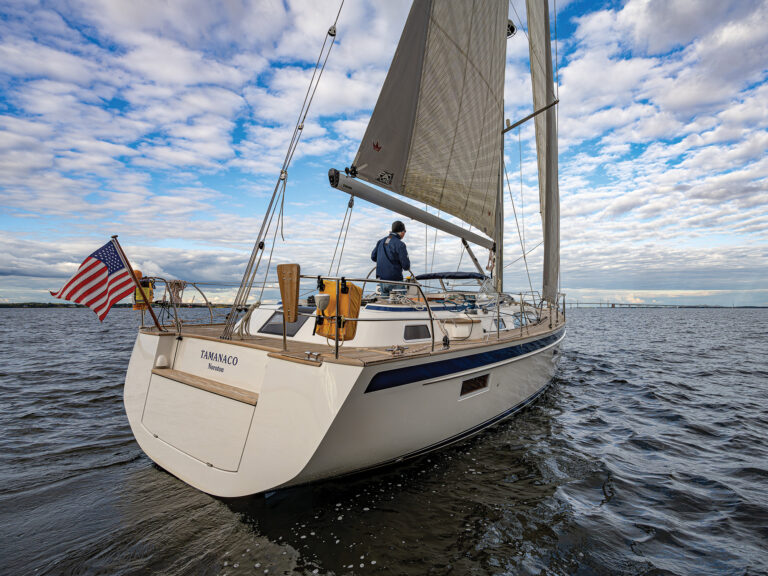
Anytime a sailor can set a spinnaker is special. A boat just seems to come alive and say thank you for adding the colorful, carefully shaped sail.
Spinnaker fabrics, shapes, setting techniques, graphics and trimming methods have all improved in recent years. When the first spinnakers appeared during America’s Cup races in the early 1900s, sailors named the innovative downwind sails in honor of film stars such as Greta Garbo and Mae West. Today, thanks to sailmakers looking for advances in speed, spinnakers are lighter, stronger, easier to set, more efficient to trim and, best of all, fast. For many boats, awkward spinnaker poles have given way to asymmetrical spinnakers.
I’ve learned that simpler is better. The key to setting a spinnaker is spending some time folding the sail properly before setting it. This is similar to the protocol of a paratrooper packing his chute. Prepare the sheets and halyard, and secure the shackles to the three corners of the sail. When everything is ready to go, the sailor at the helm needs to steer a course that allows the sail to be hoisted behind the mainsail before the sail is trimmed. It’s a magic moment when the sail fills and the boat accelerates. The crew feels the energy, and it lifts everyone’s morale.
On my 32-foot Hood daysailer, Whirlwind, I hand over the helm to my crew, and then I set up the spinnaker. I’ve arranged the tack, halyard and clew to be attached to the spinnaker from the cockpit. I do not have a bowsprit or a pole. I do not need to go up on the foredeck. The sail attaches to the tack line, which is led under the foredeck so that I can control it from the cockpit.
At one point, I was inspired to use an elaborate roller-furling arrangement to set the spinnaker. I got the idea from around-the-world-racers. It was a mess. The roller furler would wind up in one direction at the head and the other direction along the foot. It was an impossible system to use.
To figure out what I should do, I called one of my sailing heroes, Jud Smith. He patiently listened to my problem and then calmly said: “I am going to send you a spinnaker bag. Put the sail in the bag. Attach the three corners, and hoist it. When you are finished, lower the sail, and put it back in the bag. That’s it.”
I laughed as I listened intently to his sage advice. What he was really saying was, “Hey, knucklehead, just use the simple tried-and-true method of setting a spinnaker.”
I haven’t had a problem since.
Symmetrical-shaped spinnakers
These traditionally shaped sails are rounded evenly on both sides and are easily jibed with the use of a spinnaker pole. The sails work best when the deepest part of the draft of the sail is about 50 percent of the way aft.
A good check is to set the sail so that the clews are level and the center seam in the sail is about perpendicular to the horizon. Use the spinnaker pole topping lift to adjust the height of the clews. Try to keep the clews at the same height off the water. Set the spinnaker pole on the mast so that it extends at a 90-degree angle to the mast. This helps keep the spinnaker away from the boat. The air flows freely around the sail when it is set away from the mast and mainsail.
In lighter winds, say less than 11 knots, it’s easy to trim a spinnaker with a 70- to 80-degree apparent-wind angle. As the breeze builds, the boat will start overheeling, and the course to steer needs to be lower. In 20 knots of wind, a comfortable apparent-wind angle is around 110 degrees. In a strong blow, steering can be tricky. If the boat starts rolling uncomfortably, then steer a higher course. This will end the rolling. If the wind seems too strong, then the best solution is to just take down the sail.
Keep one person stationed near the spinnaker sheet. The sail should be eased out just before the sail luffs. Racing sailors adjust the trim constantly. When I am cruising or daysailing, I like to slightly overtrim the sail so that it doesn’t collapse, but I keep an eye on the sail at all times.
Asymmetrical-shaped spinnakers
These have become popular in the past 30 years. They are easy to fly, and they make boats sail swiftly.
Generally, one steers a higher course to make the asymmetrical spinnaker fly efficiently. This means that a boat will jibe through a higher angle, but the trade-off of additional speed makes the asymmetrical spinnaker a good choice. On Whirlwind, I am able to sail with the asymmetrical spinnaker with an apparent-wind angle of 60 degrees in winds under 11 knots. In a stronger breeze of, say, 17 knots, I find the most efficient apparent-wind angle to be about 105 degrees to 120 degrees.
Bowsprits help the sail set more efficiently. I learned during countless days of speed testing on America’s Cup yachts that the farther forward you can set the tack of a spinnaker, the more speed you will generate. The luff of the sail should be relatively tight and the leech somewhat looser. The asymmetrical shape has a different draft or curvature in the forward part of the sail compared with the after part of the sail. There are times when I will ease off the tack line several inches to help the sail fly a little better, particularly in lighter winds. I suggest experimenting with the height of the tack to judge what makes the sail work best.
A convenient method of setting an asymmetrical spinnaker is to use a snuffer tube. The sail is zipped into a long tube that is hoisted to the top of the mast. Once the sail is all the way up, the tube is unzipped and the spinnaker fills.
It is a thing of beauty to see the sail fill with air. The lead of the spinnaker sheet should be set so that the sail flies with a leech that is open but not fluttering. As the wind builds, moving the spinnaker-sheet lead aft helps to keep the sail under control. In lighter winds, the lead should be moved forward to keep the leech of sail a little tighter. Spend some time experimenting where the best position for the lead should be set.
I suggest having at least two lead positions. If the sail seems to luff at the top of the sail first, then move the lead forward. If the spinnaker luffs near the foot first, then move the lead aft.
The trickiest part of using an asymmetrical spinnaker is jibing. On Whirlwind, I always use an inside jibe, where the sail switches sides of the boat with the clew inside the tack. Outside jibes work well when there is a good breeze of 11 knots or more, but they can be difficult to execute with a small crew. Prepare your crew in advance of a jibe. Good steering is important when jibing. Pick a point on land to head toward, or note the new compass course you will be steering before starting your turn. Trim in the mainsail as it swings across to control it. Make sure everyone’s head is down. Have some fun, and practice.
I have been able to set the asymmetrical spinnaker to windward when sailing straight downwind. The mainsail is on one side of the boat, and the spinnaker is set on the windward side of the boat. The person at the helm has to be careful to keep the spinnaker flying to windward. Sometimes I steer a course that is slightly by the lee to make the arrangement work.
A word of caution: Watch the boom. It easily can come flying across when you’re sailing by the lee. Easing the tack will help give the spinnaker a faster shape when you trim it to windward.
The spinnaker trimmer must be in a good position to see the whole sail. A slight curl in the luff of the sail is acceptable. Try to keep the sail from collapsing because it stresses the fabric, slows the boat, and makes the crew uncomfortable.
Trimming spinnakers
The person steering and the spinnaker trimmer should work together.
When the trimmer feels more wind velocity in the sail by the tension on the sheet, he or she should tell the person at the helm to bear off and sail a lower course. This will help you gain distance to leeward. When the wind velocity drops, ask the helm to steer a higher course to maintain boatspeed.
Rotate crew during the sail so that everyone has a chance to trim and steer. If the sail looks out of balance, then make the adjustment to get the sail to set as discussed above.
Staysails
Spinnakers fly best with little interference from additional sails. At times, staysails can add speed in moderate wind and when sailing on a reach. The slot created between a staysail and the spinnaker and the mainsail creates good airflow.
If the wind is light (less than 7 knots), then the staysail will draw the spinnaker toward the hull of the boat and slow it down. A staysail on a roller furler makes it easy to experiment to see if the sail adds or subtracts boatspeed. In most cases, I find that the headsail should be rolled up or dropped to help the spinnaker set properly.
Be creative with your spinnaker’s color pattern. If you own a spinnaker, set it anytime you are sailing with the wind. Other crews will give you a hearty wave when you pass by with a spinnaker flying.
If you don’t own a spinnaker, consult with your sailmaker and get one. It is as simple as hoisting the sail out of the bag and letting the boat take off.
CW editor-at-large Gary Jobson has a hard time deciding if he likes cruising or racing more.








